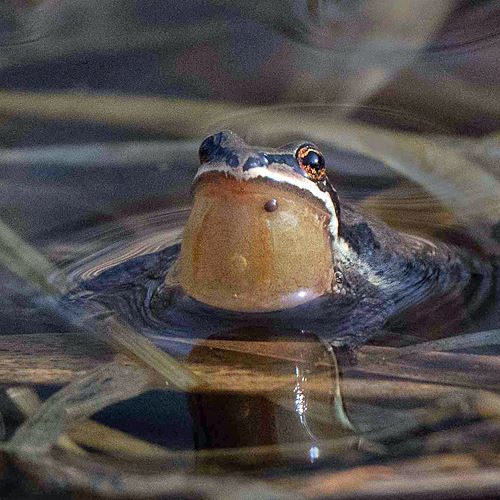It's Amphibian Eruption Time

By Karen Menard
From the depths of the cold but thawing earth this spring, mobs of drowsy frogs and toads will soon be making their way toward the nearest northwest Ohio wetland to beckon the coming of spring—in stereo!
Natural areas once quiet, will be transformed with the loud cadences of chorus frog “crrrreeeeeeeeks,” percolations of spring peeper “peeps,” concertos of the wood frog’s duck-like “cack-a-hack-a-hack” and throaty trills of the American toad.
Why all of the melodic fuss so early in the season? Spring wetlands essentially become the amphibian place to be! They provide a supreme location for male and female frogs and toads to gather in a mixer setting for a variety of nightly social interactions. Males tend to be the first to arrive at these swampy soirees-- announcing their grand appearances with distinct “advertisement” calls.
A single call will go a long way, spurring additional calls from other individuals, producing vociferous choruses that rise and fade. Females easily recognize males of their own kind from their unique call melody.
“Aggressive” or “territorial” calls can also be produced by males, alerting any uninvited froggy intruders to hop along in the opposite direction of claimed territories. Larger, aggressive males are able to defend the best breeding spots and attract the most females.
Singing night after night takes a lot of energy but plays a crucial role in the continued success of amphibian breeding efforts. To accomplish this spring feat, frogs and toads possess specially adapted physical features in order to produce these unique sounds.
Surprisingly, almost all call sounds are actually produced with a closed mouth using their vocal cords, with some physical differences among frog and toad types. However, for most, the air is first drawn into the nostrils to inflate the lungs and vocal sac(s). After this step occurs, the nostrils and mouth are both closed off. Next, the air is quickly pushed back and forth from the lungs into the vocal sac(s) over the vocal cords causing vibration to occur, creating sound. The inflated, balloon-like vocal sac(s) is responsible for sound resonance and why, sometimes, frogs are heard “in stereo.”
During the early months of spring, in March and April, take a walk in Oak Openings Preserve or Secor Metropark to hear booming choruses of spring peepers, wood frogs, chorus frogs and American toads. Their symphonic sounds from the nearest ditch, vernal pool or floodplain not only announce the arrival of warmer days, but are key to sustaining future generations of their species for seasons to come.
Did You Know?
The type of frog and toad sound produced is affected by the air speed over the vocal cords.
--
Photos: Chorus frogs with inflated vocal sacs
